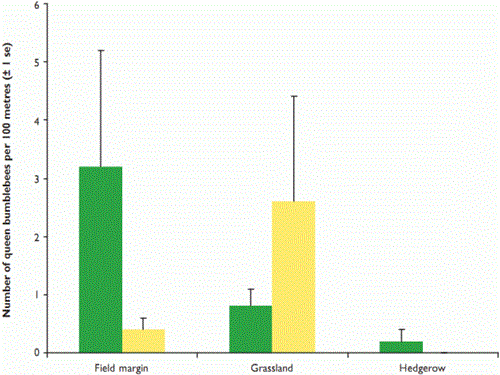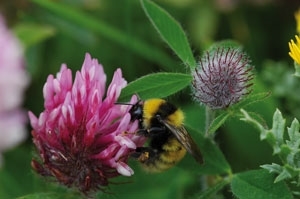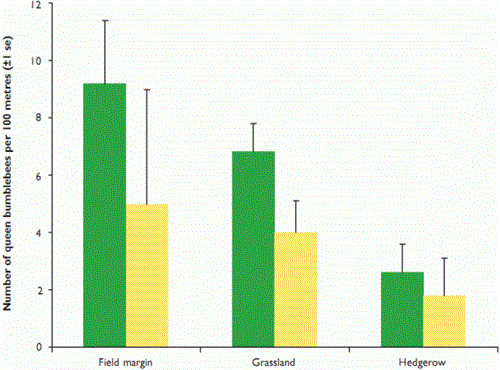 Bumblebees are beacons of spring and have a very special place in the hearts of the British public. However, they also play an important economic and ecological role by pollinating crops and wildflowers. The UK has 25 native bumblebee species, but many of these have declined in recent years.
Bumblebees are beacons of spring and have a very special place in the hearts of the British public. However, they also play an important economic and ecological role by pollinating crops and wildflowers. The UK has 25 native bumblebee species, but many of these have declined in recent years.
Agricultural change has led to big decreases in floral abundance and diversity in the rural environment, reducing the availability of important bumblebee forage plants such as red clover. It has also caused the loss of many field boundary features such as hedgerows and stone walls, which are good nesting sites for bumblebees. This loss of habitat is thought to be the main reason why bumblebee numbers have declined. Bumblebees are active from early spring until late summer, but conservation efforts focus on providing forage for workers in the summer, although bumblebees are probably more sensitive during the period of nest foundation and early colony growth in the spring.
In 2008, we compared numbers of bumblebee queens foraging and searching for nest sites in three existing agri-environment habitats that were either managed conventionally or according to the Scottish Rural Stewardship Scheme (RSS) 2004. We surveyed 10 farms five times and, of these, five were participating in RSS and had at least two of the following RSS habitats: grass margins or beetle banks, managed hedgerows and species-rich grassland.
The grass margins or beetle banks were 1.5 to six metres wide, sown with a suitable grass mix and uncut or grazed until after harvest. The managed hedgerows were only cut once in every three years, any gaps were filled and the hedge base remained uncut. Species-rich grassland was either unimproved grassland or sown with a grass-flower mix which remained uncut or grazed between March and mid-August.
Figure 1: Average number of bumblebee queens seen foraging in five Rural Stewardship and 15 conventionally-managed habitats in Scotland in 2008

The number of queen bees foraging was significantly different in each habitat.
 Hedgerows were least attractive to spring queens and RSS management made no difference to the numbers of bumblebees observed foraging or searching for nest sites (see Figures 1 and 2). Conventionally-managed (naturally-regenerated) grasslands contained many bumblebee forage plants and attracted high numbers of foraging bumblebee queens, whereas RSS managed species-rich grassland, attracted few foraging queens (see Figure 1), but many of those were searching for nest sites (see Figure 2). This was probably because the complex dense vegetation structure associated with RSS grassland attracted small mammals, the abandoned burrows of which provide nest sites for bumblebees, but also prevented spring-flowering bumblebee forage plants from invading. RSS management improved field margins for both foraging queens and those searching for nest sites (see Figures 1 and 2). The grass mix sown as part of the management prescription produced the complex dense vegetation structure attractive to bumblebees searching for nest sites whereas the regular disturbance as a result of the movement of farm machinery allowed invasion by spring-flowering plants.
Hedgerows were least attractive to spring queens and RSS management made no difference to the numbers of bumblebees observed foraging or searching for nest sites (see Figures 1 and 2). Conventionally-managed (naturally-regenerated) grasslands contained many bumblebee forage plants and attracted high numbers of foraging bumblebee queens, whereas RSS managed species-rich grassland, attracted few foraging queens (see Figure 1), but many of those were searching for nest sites (see Figure 2). This was probably because the complex dense vegetation structure associated with RSS grassland attracted small mammals, the abandoned burrows of which provide nest sites for bumblebees, but also prevented spring-flowering bumblebee forage plants from invading. RSS management improved field margins for both foraging queens and those searching for nest sites (see Figures 1 and 2). The grass mix sown as part of the management prescription produced the complex dense vegetation structure attractive to bumblebees searching for nest sites whereas the regular disturbance as a result of the movement of farm machinery allowed invasion by spring-flowering plants.
Figure 2: Average number of bumblebee queens seen searching for nest sites in five Rural Stewardship and 15 conventionally-managed habitats in Scotland in 2008

Field margins and grassland habitat were not significantly different from each other in the numbers of queen bees searching for nest sites, but there were significantly fewer bees searching in hedgerows than in either grassland or field margins.
These findings suggest that some simple management prescriptions can provide benefits for bumblebee queens foraging during the spring or searching for nest sites, whereas others can benefit both. Helping bumblebee queens early in the year should be rewarded with disproportionate benefits compared with provision for workers later in the year, as it encourages the foundation of bumblebee colonies and helps establish a robust local population which will pollinate crops later in the year.
Acknowledgements
We are grateful to the Scottish Executive, and landowners and managers of the farms included in the study, to the University of Stirling for facilities and the Natural Environment Research Council for part funding.